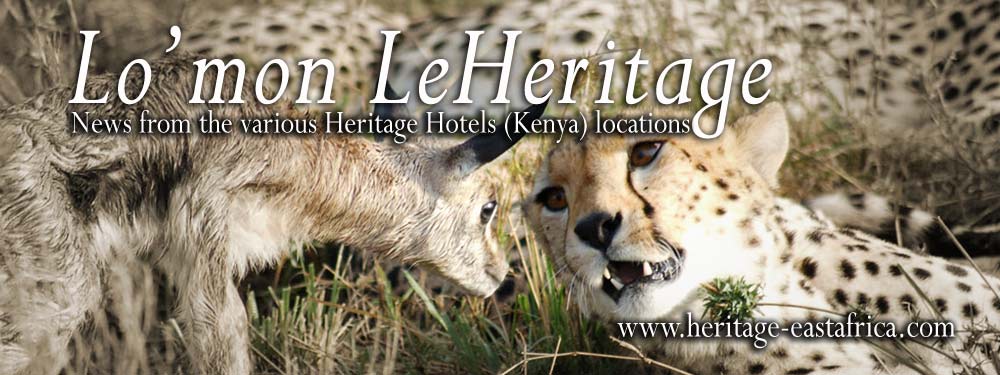After the heavy rains, there is now plenty of food on the plains for the animals especially the herbivores. By the end of last year, the migrating herds of wildebeests and zebras had left for the Serengeti. The remaining animals, mainly herbivores, are concentrated in areas where the grass is short.
 Unlike the time of the drought last year when the grass had dried up, it is now growing fast. This makes it difficult for the prey to see the predators until it’s too late. Unfortunately for the mammals, tall grass also harbors tsetse flies and ticks, forcing them to move to the plains where the grass is shorter.
Unlike the time of the drought last year when the grass had dried up, it is now growing fast. This makes it difficult for the prey to see the predators until it’s too late. Unfortunately for the mammals, tall grass also harbors tsetse flies and ticks, forcing them to move to the plains where the grass is shorter.The weather is great. The mornings are cool with temperatures as low as 13ºC rising to around 35 ºC by midday. There’s not too much dust unlike the time of the drought.
Big Cats
Lions
The two lion prides, the Ridge Pride and the Olkiombo Pride in our game viewing areas have been quite active this week. The Ridge Pride, including Notch and three other males killed an ostrich about five days ago and yesterday (30 January) killed an adult hippo on Paradise Plains.
The two males from Olkiombo Pride killed a hippo near the Double Crossing area on the Mara River. They were later joined by the females.
Leopards
Olive was seen two days ago at Olare-Orok River hunting some impala. Her two cubs were seen earlier with her on the Talek River. Kali has moved towards the Mara River north of the Talek-Mara junction.

Cheetahs
Since last week, the three cheetah brothers have been roaming the plains between the Talek and Musiara, hunting the young ones of the Topi and other herbivores.
 There is a female cheetah with a cub around the Bila Shaka area. This is a very risky area because of the Marsh Pride and a pack of hyenas. Besides making it difficult for her to hunt, the lions and the hyenas are a danger to the safety of the cheetah and her cub. We will keep you posted on them.
There is a female cheetah with a cub around the Bila Shaka area. This is a very risky area because of the Marsh Pride and a pack of hyenas. Besides making it difficult for her to hunt, the lions and the hyenas are a danger to the safety of the cheetah and her cub. We will keep you posted on them.Samburu National Reserve
With a reputation as as a dry semi-arid and unforgiving land, Samburu is in fact one of Kenya's most unknown gems. A pristine wilderness in the Northern Frontier district, the land is just as beautiful as the people, who's culture and way of life is uninterrupted as their Masai cousins found to the south of Kenya.
Our guests at Samburu Intrepids found these animals on a game drive just a couple of days ago. The ostrich and Grevy's zebra were spotted on the Buffalo Springs side while the rest were on a the Samburu National reserve side.



As skilled Samburu guides will tell you, in Samburu game is 'spotted', not viewed! They say it calls for greater skill to see animals which are fewer than in the Mara, as this picture of a leopard on the tree attests.

He obliges a photo op!

A reticulated giraffe reaches for the tastiest snacks on the highest branch.


Female members of an impala harem.

An elephant reaching for fresh shoots.

And now the latest buzz in Samburu - this pack of Cape Hunting dogs, also known as African Wild dogs (scientific Lycaon pictus) has been seen severally while on game drive.

Surely they didn't for a moment think they could bring down a giraffe!

The leopard and elephants below were seen just yesterday. The life giving Uaso (Ewaso) Nyiro is flowing and animals are easy to spot.




 The elephant matriarch leads the herd across the river. They are encouraging the calf along.
The elephant matriarch leads the herd across the river. They are encouraging the calf along.Tsavo West National Park
Our resident naturalist in Voyager Ziwani Camp, Stephen Lekatoo, has sent an interesting look at things from Tsavo. This is the breeding season for crocs, and the resident crocs are laying eggs. Unfortunately they have come under attack from monitor lizards. One of the female crocs, aptly named Kasheshe, was pictured fending off an attack by the giant lizards. They also have to portend with hippos which trample on their eggs or even kill the hatchlings.

A visit to Tsavo West National Park would not be complete without a visit to Baobab tree; Lake Challa on Kenya's border with Tanzania which lies in a crater, with some of the clearest waters you'll ever see; Mzima Springs with it's pure waters from the Mt Kilimanjaro, filtered and purified through volcanic rocks; and a hike up Salaita Hills scene of the battle trenches built by the German Army during the first world war.

Lake Challa.
 Salaita Hills, battle fields of German army during First World War.
Salaita Hills, battle fields of German army during First World War. Baobab tree. Legend has it that a German sniper lady used to hide in this tree and even killed 30 British troops.
Baobab tree. Legend has it that a German sniper lady used to hide in this tree and even killed 30 British troops.
Paul Kirui, Chief Safari Guide, Heritage Hotels, Francis Lenyakopiro, Resident Naturalist, Samburu Intrepids and Stephen Lekatoo, Resident Naturalist, Voyager Ziwani Tsavo
